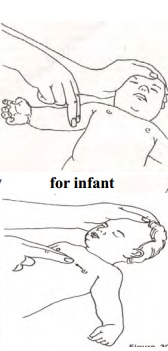Chapter: 11th 12th std standard Class Nursing Health Care Hospital Hygiene Higher secondary school College Notes
First Aid - CPR for small children and infants

CPR for small children
1.
Use the head-tilt/neck-lift (as
shown) or head-tilt/chin-lift method to open the airway. You may need to use
two or three fingers instead of your whole hand to lift the child' s neck if it
is very small.
2.
If you use the head-tilt/chin-lift
method, be careful not to close the child' s mouth when you lift his chin.
Also, be sure your fingers are not pressing on the soft tissue under his chin,
which may cause edema and subsequent airway obstruction.
3.
If the child' s face is large
enough, maintain a tight seal by pinching his nostrils (as shown) and placing
your mouth over his. If he has a small face, place your mouth over his mouth
and nose. When ventilating, give only enough air to make the child' s chest
rise.
4.
Try
to palpate the child' s carotid pulse. If you find a pulse, do not give cardiac
compression but do ventilate the child at a rate of one breath every
5.
4
seconds. If you can' t locate a pulse, find the proper location for
compression. Use the same technique you would for an adult.

Then compress about 1 to 1.1/2 inches (2.5 to
3.8 cm), using the heel of one hand (as shown).
Give 80 compressions a minute, with
a breath after every fifth compression. Your count should be: 'One and two and
three and four and five and one…' and so on.
This rate and ratio are the same if
you have a second rescuer helping you, but the second rescuer should ventilate
on the upstroke of the fifth compression.
CPR for infants
1) When
you tilt an infant' s head, you will lift up his back as well. So before
opening an infant' s airway, place a rolled towel of your hand closest to his
feet beneath his back to support it.
Then gently tilt his head back. You
don' t need to neck.
Cover both his mouth and node with
your mouth. To ventilate, give only small breaths - just enough to make his
chest rise.
If you are having trouble
ventilating the infant, his stomach may be distended, limiting chest expansion.
Don' t relieve gastric distension
unless absolutely necessary, because the infant may aspirate stomach contents.
But if his abdomen is so tense you
can' t ventilate, turn him onto his right side and gently press on his
epigastric region.

Gastric distension is caused by
delivering too much air, so give only enough air to make the infant' s chest
rise.
Because an infant' s neck is short and chubby, palpate his
brachial rather than carotid pulse.
The brachial pulse is located on the
inside of the upper arm, midway between the shoulder and the elbow.
Don' t palpate his apical pulse -
what you think is a pulse may be just precordial activity.
To locate your hand position for
cardiac compression, draw an imaginary line between the infant's nipples. (An
infant' s heart is located higher in the chest than a small child' s or adult'
s).
Place two or three fingers in the middle of this line.
Deliver about 100 compressions a minute, giving a breath after every five
compression.
Count to yourself: 'One, two, three,
four, five' (even though you are alone). Because an infant is so small, one
rescuer along can try to resuscitate him.
Related Topics